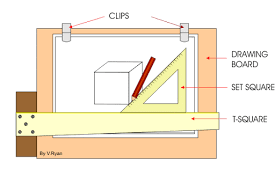Back to: Basic Technology JSS 1
Welcome to class!
In today’s class, we will be talking about drawing practice. Enjoy the class!
Board Practice, Drawing Practice

Board Practice is the appropriate use of the drawing board to practically do a technical drawing. This is done with lettering guidelines and lettering styles. A profession that needs technical drawing are: engineers, technicians, draughtsman, welders, and furniture makers, designers (CADD or CAD)
If you want to get better at something you need to practice regularly.
Of course, you do. No-one would argue with that. But regular practice alone isn’t enough. There are good and bad ways to practice.
My own experience of teaching myself to draw over the last few years has taught me this: Practice ineffectively, and you’ll be putting in huge amounts of effort for very little reward. Practise effectively, and you can progress much faster than you would have thought possible with much less effort.
Drawing paper must be set up on a drawing board using a T-square. Once in position, the paper is clipped to the board with board clips or even masking tape.
- The T-square must be placed up against the edge of the drawing board. There must be no gaps otherwise the paper will not be set up correctly and drawing accurate horizontal and vertical lines will be impossible.

- The paper is then allowed to rest on the T-square. Check that the paper rests properly on the T-square and that there are no gaps between the T-square and the paper OR the T-square and the side of the drawing board.
- A 2H pencil can then be used to draw faint horizontal lines across the page. Try to keep the lines to the same size by measuring them with a ruler.
Each time you draw a line check that the T-square is pressed completely against the edge of the board. There should be no gaps. - To draw vertical lines a T-square and set square are used together.
Be careful to check that there no gaps between the T-square and the board AND the set square and the T-square. Do not draw vertical lines with a set square only as they will not be accurate.
Great care should also be taken to ensure that the paper does not move. This can happen if a hand or arm rubs too strongly against the paper. Check that the paper has not moved by placing the T-square at the bottom edge of the paper. Then check that the paper rests level against the T-square and that the paper is not at an angle. Ensure that the T-square is also firmly against the edge of the board.
In our next class, we will be talking about Board Practice: Lettering. We hope you enjoyed the class.
Should you have any further question, feel free to ask in the comment section below and trust us to respond as soon as possible.

Nice